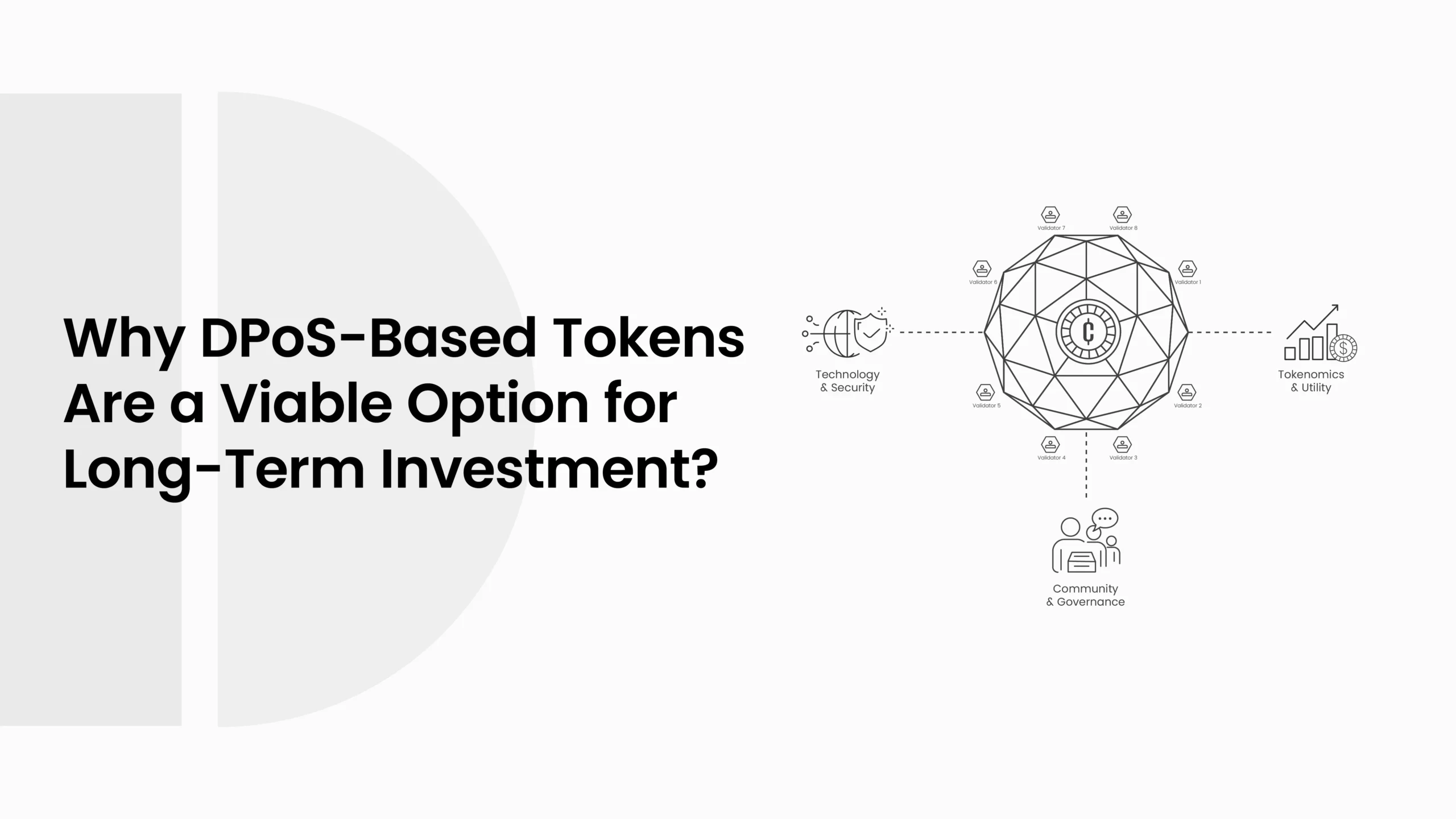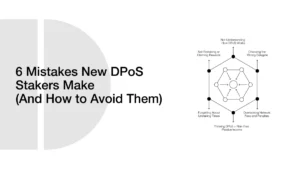Why DPoS-Based Tokens Are a Viable Option for Long-Term Investment?

Recent years have seen increasing scrutiny of blockchain consensus mechanisms, especially as they impact token economics and long-term investment decisions. Delegated Proof of Stake (DPoS), originally seen as an innovation to address scalability and governance issues, has now become a popular system. The questions about the appropriateness of these tokens for long-term portfolios are no longer hypothetical, as projects like EOS and TRON still rely on DPoS or hybrid models.
- How DPoS Works and Why It’s Different from Other Systems
- What Token Inflation Means for Investors
- Who Holds the Power in DPoS Governance?
- Looking Back at Market Performance and Price Trends
- Can DPoS Networks Keep Up with Change?
- Regulation is Catching Up with DPoS Systems
- Staking Rewards: More Than Just a Number
- Final Thoughts: What Long-Term Investors Should Watch
- Frequently Asked Questions About DPoS-Based Tokens
- What makes DPoS different from other blockchain consensus systems?
- Why do some investors view DPoS tokens as risky long-term assets?
- How does token inflation affect DPoS token prices?
- Are DPoS tokens considered securities by regulators?
- Glossary of Key Terms
As investor attention moves beyond the hype cycles of token launches and speculative trading, it has become increasingly necessary to take a closer look at the structural and technical foundations of DPoS tokens. To assess their viability as long-term investments, it is necessary to deconstruct their consensus model, study tokenomics, and evaluate the reality of validator behavior, governance centralization, and incentive sustainability.
ALSO READ: DPoS Explained: Pros and Cons of Delegated Proof of Stake in 5 Minutes
How DPoS Works and Why It’s Different from Other Systems
DPoS is created on the principles of the delegation system, according to which the owners of tokens elect a small number of validators, who are entrusted with the task of keeping the network. DPoS utilizes no computing power (as Proof of Work, PoW) or direct correlation to influence stake size (as Proof of Stake, PoS). This kind of setup allows more transaction throughput and lower charges, qualities that have been appealing to those platforms that place value on speed and scalability.
Efficiency, however, is a cost. The delegation process usually results in the concentration of power in the hands of a small group of influential validators. An analyst once observed that these systems are likely to create dominance by the validators, which casts doubt on the actual decentralization and long-term fairness in governance.
Having learned the working model of DPoS, it is necessary to analyze the financial model that supports it.
What Token Inflation Means for Investors
DPoS networks commonly distribute newly minted tokens as rewards to validators and, in many cases, to the voters who support them. This inflation-driven incentive model aims to encourage participation and maintain the network’s security. At first glance, the prospect of earning regular staking rewards can be appealing to investors.
Yet the economic consequences of inflation are not always favorable. When the token supply increases without matching demand growth, purchasing power can decline. Kwon et al. (2021), writing in the Journal of Cryptoeconomics, emphasized that token inflation in several DPoS systems has outpaced network utility, leading to long-term price suppression.
This raises questions about sustainability. If returns are largely a product of inflation rather than real economic activity, long-term value may be undermined. Understanding these risks provides context for another critical factor in DPoS: who controls the decision-making power.
ALSO READ: How EOS Uses Delegated Proof of Stake (DPoS) to Handle High Transaction Volumes
Who Holds the Power in DPoS Governance?
The premise of community-driven governance is central to DPoS. In reality, however, power may become highly concentrated in the hands of a few validators or pools of delegates. Voting systems are normally influenced by the large stakeholders who can develop alliances in order to hold on to their seats. The result of these informal arrangements may be what Zhang and Zhou (2022) wrote on arXiv as validator cartels, which control block production and policy votes and lessen democratic accountability.
This concentration can not always cause a threat to the network stability, but it can affect protocol decisions and prevent technical upgrades or reforms. Investors are affected by the long-term implications. A network that is managed by a small group of people can be less flexible, less transparent, and susceptible to reputational risk.
In spite of these governance concerns, there are still investors who find the DPoS tokens appealing, usually due to their behavior in bull markets. In order to analyze their potential, it is convenient to examine how these tokens have performed in the past in financial terms.
Looking Back at Market Performance and Price Trends
DPoS tokens often show strong market interest during early stages or speculative cycles. This can be attributed to initial staking yields, marketing momentum, or perceived technological advantages. However, data from CoinMetrics (2023) shows that over five years, many leading DPoS tokens have underperformed compared to Bitcoin or Ethereum.
While short-term gains may occur during bullish phases, long-term appreciation has remained limited in most cases. The reasons are varied: inflationary token supply, unclear demand drivers, and governance stagnation have all played a role. This performance pattern suggests that DPoS tokens may not function as effective stores of value over extended periods.
Given these challenges, the next logical step is to assess how well these systems adapt and grow over time.
ALSO READ: Proof of Work vs Delegated Proof of Stake: How DPoS Consensus Differs from PoW
Can DPoS Networks Keep Up with Change?
The rate of protocol upgrades is one of the issues in DPoS ecosystems. Although in theory, delegation is supposed to simplify the coordination process, technical updates still need to be validated by consensus. This may cause bottlenecks in the case of misalignment of interests. The development of such projects as Steem and Lisk has been stagnated because of internal governance conflicts.
Conversely, platforms with formalized upgrade processes, such as on-chain voting, have enabled them to adjust faster. In ACM CCS, Bonneau et al. (2021) noted that blockchains whose upgrade processes are less turbulent are more secure and relevant in the long term.
This supports a vital investment implication: the capacity of a DPoS network to change is firmly associated with the mechanism of decision-making and the people in charge. In addition to technical concerns, there are also legal and regulatory concerns that are informing the long-term prospects of these tokens.
Regulation is Catching Up with DPoS Systems
As DPoS platforms mature, they are drawing more attention from regulators. This is particularly relevant when staking rewards are viewed as financial returns, potentially categorizing the tokens as securities. The U.S. Securities and Exchange Commission (SEC) has already taken enforcement action against several blockchain projects with DPoS-like models.
The legal uncertainty can affect everything from exchange listings to developer activity. A 2023 report by the Blockchain Association pointed out that DPoS networks may face additional hurdles unless they demonstrate decentralized control and functional utility. For investors, this adds another layer of risk, especially when legal outcomes remain unresolved across major jurisdictions.
Still, many are drawn to DPoS tokens by their staking rewards. A closer look at these returns reveals more complexity than often advertised.
Staking Rewards: More Than Just a Number
The most popular reward is the staking reward that is promoted as an advantage of owning DPoS tokens. However, the true pay-off may be hard to estimate effectively. Yields can be variable, and headline rates can lack inflation, validator fees, or network downtime. A study by Delphi Digital (2023) revealed that real staking returns tend to decrease with network age and with a tightening of inflation rates.
Also, there are risks associated with staking, including slashing, where the validators, together with their delegators, can lose a portion of their stake due to misconduct or network downtime. These aspects decrease the predictability of rewards, particularly in unpredictable markets.
Although there is a level of rewards, these are subject to the overall health and governance of the network, and thus reliant on them. All these observations culminate in one last point: the way to be strategic about DPoS tokens within the larger blockchain ecosystem.
Final Thoughts: What Long-Term Investors Should Watch
DPoS offers clear technical advantages, including faster transactions and lower energy use. However, its economic and government frameworks are suspect of long-term stability and worth. The factor of token inflation, the centralization of the validators, and the pressure of regulation make the picture of investments more complicated than it could be with only the returns on staking.
The lesson to blockchain developers is that they can develop systems that can provide performance and plausible decentralization, and open governance. Further studies of the validator incentives and voting patterns are important to researchers. The investors need to consider long-term network health, flexibility, and compliance risks and look beyond the short-term yield.
The blockchain infrastructure still revolves around DPoS tokens. Their prospect as good long-term investments do not just lie in the advantages that they are bound to bring but also in their sustainability when they face economic crunch, government, and legal constraints in the future.
Frequently Asked Questions About DPoS-Based Tokens
What makes DPoS different from other blockchain consensus systems?
DPoS uses a voting system where token holders elect a small number of validators, called delegates, to produce blocks. Unlike Proof of Work, which relies on energy-intensive mining, or Proof of Stake, which links influence directly to token size, DPoS aims to increase transaction speed and governance participation.
Why do some investors view DPoS tokens as risky long-term assets?
While DPoS networks provide scalability and energy efficiency, they often face issues like validator concentration, inflation-driven rewards, and slower protocol upgrades. These factors can reduce long-term price growth and stability.
How does token inflation affect DPoS token prices?
Most DPoS blockchains distribute new tokens as validator rewards, increasing total supply. If demand doesn’t grow at the same rate, inflation can erode value over time. This can suppress token prices and reduce real returns for investors.
Are DPoS tokens considered securities by regulators?
In some jurisdictions, staking rewards are viewed as financial returns, which can bring tokens under securities regulation. The U.S. SEC, for instance, has pursued enforcement actions against certain staking-based projects, creating uncertainty for DPoS ecosystems.
Glossary of Key Terms
Delegated Proof of Stake:
A blockchain consensus mechanism where token holders elect a small number of validators to confirm transactions and produce new blocks.
Validator / Delegate:
A trusted participant chosen through token holder voting to maintain the network and validate transactions.
Token Inflation:
The increase in total token supply over time, often used to reward validators and voters in DPoS systems.
Governance Centralization:
A condition where decision-making power becomes concentrated among a few validators or token holders, limiting network fairness.
Staking Rewards:
Earnings given to participants who lock up their tokens to support network operations or vote for validators.
Slashing:
A penalty applied to validators or delegators for malicious actions, poor performance, or network downtime.
Protocol Upgrade:
A change or improvement in a blockchain’s underlying code, usually requiring validator or community approval.
Validator Cartel:
A small group of validators that coordinate actions or vote trading to maintain control over network governance.
Throughput (TPS):
The number of transactions a blockchain can process per second, a key measure of scalability.
Hybrid Consensus:
A system that combines DPoS with another mechanism (e.g., PoS) to balance performance and decentralization.




